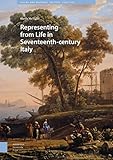Representing from Life in Seventeenth-century Italy / Sheila McTighe.
Material type: TextSeries: Visual and Material Culture, 1300 –1700 ; 20Publisher: Amsterdam : Amsterdam University Press, [2020]Copyright date: ©2020Description: 1 online resource (252 p.)Content type:
TextSeries: Visual and Material Culture, 1300 –1700 ; 20Publisher: Amsterdam : Amsterdam University Press, [2020]Copyright date: ©2020Description: 1 online resource (252 p.)Content type: - 9789048533268
- Art, European -- 17th century
- Art, Italian -- 17th century
- Portrait drawing, Italian -- History -- 17th century
- Portrait painting, Italian -- History -- 17th century
- Art and Material Culture
- Cultural Studies
- Early Modern Studies
- History, Art History, and Archaeology
- ART / European
- Bamboccianti
- Caraavaggio
- Claude Lorrain
- Jacques Callot
- ad vivum
- realism
- online - DeGruyter
| Item type | Current library | Call number | URL | Status | Notes | Barcode | |
|---|---|---|---|---|---|---|---|
 eBook
eBook
|
Biblioteca "Angelicum" Pont. Univ. S.Tommaso d'Aquino Nuvola online | online - DeGruyter (Browse shelf(Opens below)) | Online access | Not for loan (Accesso limitato) | Accesso per gli utenti autorizzati / Access for authorized users | (dgr)9789048533268 |
Browsing Biblioteca "Angelicum" Pont. Univ. S.Tommaso d'Aquino shelves, Shelving location: Nuvola online Close shelf browser (Hides shelf browser)

|

|

|

|

|

|

|
||
| online - DeGruyter Sex, Drugs and Rock 'n' Roll in the Dutch Golden Age / | online - DeGruyter Re:Thinking Europe : Thoughts on Europe: Past, Present and Future / | online - DeGruyter Fish Trade in Medieval North Atlantic Societies : An Interdisciplinary Approach to Human Ecodynamics / | online - DeGruyter Representing from Life in Seventeenth-century Italy / | online - DeGruyter Premodern Rulership and Contemporary Political Power : The King's Body Never Dies / | online - DeGruyter Saint Anthony's Fire from Antiquity to the Eighteenth Century / | online - DeGruyter Saints, Infirmity, and Community in the Late Middle Ages / |
Frontmatter -- Acknowledgements -- Table of Contents -- Illustration List -- Introduction: From Life -- 1. Caravaggio’s Physiognomy -- 2. Jacques Callot, Drawing Dal Vivo in 1620: Commerce in Florence, Piracy on the High Seas -- 3. Jacques Callot’s Capricci di varie figure (1617): The Allusive Imagery of the Everyday, Represented ‘from Life’ and Emulating a Text -- 4. The Motif of the Shooting Man, and Capturing the Urban Scene: Claude Lorrain and the Bamboccianti -- 5. The absent eyewitness: the Revolt of Masaniello and depiction dal vivo in the middle of the seventeenth century -- Conclusion -- Index
restricted access online access with authorization star
http://purl.org/coar/access_right/c_16ec
In drawing or painting from live models and real landscapes, more was at stake for artists in early modern Italy than achieving greater naturalism. To work with the model in front of your eyes, and to retain their identity in the finished work of art, had an impact on concepts of artistry and authorship, the authority of the image as a source of knowledge, the boundaries between repetition and invention, and even the relation of images to words. This book focuses on artists who worked in Italy, both native Italians and migrants from northern Europe. The practice of depicting from life became a self-conscious departure from the norms of Italian arts. In the context of court culture in Rome and Florence, works by artists ranging from Caravaggio to Claude Lorrain, Pieter van Laer to Jacques Callot, reveal new aspects of their artistic practice and its critical implications.
Mode of access: Internet via World Wide Web.
In English.
Description based on online resource; title from PDF title page (publisher's Web site, viewed 03. Jan 2023)


